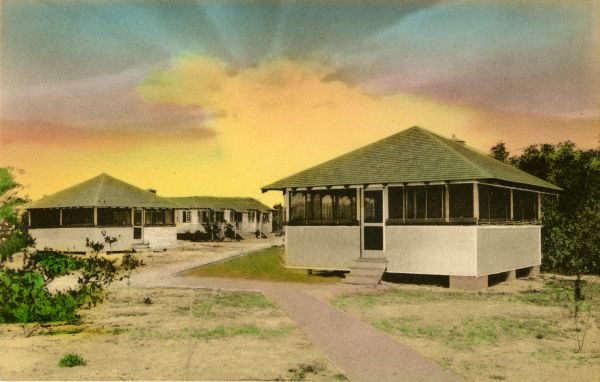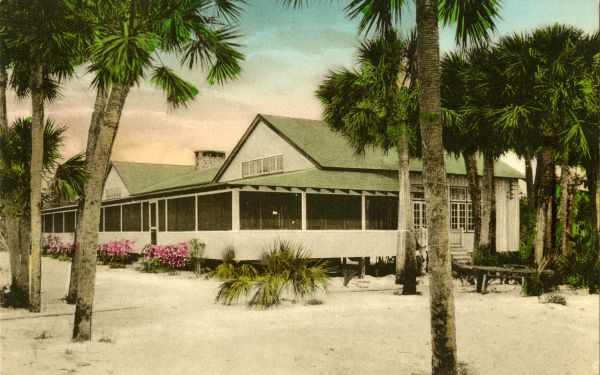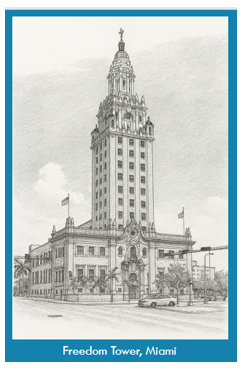- Home
- Florida History
- Florida Heritage Sites
- Keewaydin Club
KEEWAYDIN CLUB
By Mike Miller November 18 2025
OVERVIEW
Keewaydin Club was at the north end of Keewaydin Island about a half-mile off the coast of Naples, Florida. The site included a main lodge and cottages built as a private winter retreat. It covered 35 acres of coastal hammock and beachfront.
Its structures blended frame vernacular style with simple roofs and piers. The area where it was located borders Rookery Bay National Estuarine Research Reserve.
The island has white tailed deer, wild boar, bobcats and gopher tortoises. Keewaydin Club was open from 1922 to 1999.
 1900s postcard of Keewaydin Club
1900s postcard of Keewaydin ClubAccompanying note says: "Girls dormitory in the background."
Courtesy of Florida Archives
HISTORICAL SIGNIFICANCE
The island was originally known as Kee Island and was later renamed as Keewaydin Island after joining the Keewaydin Camps Ltd. company.
The Keewaydin Club earned its historic designation for its architectural and cultural ties to early 20th-century outdoor recreation and the broader Keewaydin Movement.
The Keewaydin Movement was a pioneering educational philosophy emphasizing nature-based learning and character building through traditional camp activities like fishing, hiking and archery.
The club was built in 1935 by Chester Kittredge as a winter retreat. The site's contributing buildings (lodge, cottages, and support structures) demonstrated vernacular Florida architecture adapted for leisure.
Simple frame designs on brick piers with gable or hipped roofs used local cypress and pine to harmonize with the coastal hammock.
The Club promoted "rustic" escapes for urban elites, echoing the movement's roots in Frederick William Gunn's 1849 camps for boys in Connecticut.
Its significance lies in its rarity as one of the few surviving private clubs linked to this philosophy in Florida. It documents the 1930s shift from wild frontiers to curated wilderness amid the state's tourism boom.
People accessed the club by the 21-foot long ferry Kokomis, now part of the Collier County Museum. There were no cars or vehicles except for a golf cart at the club.
The club was the second Florida site added to the U.S. National Register of Historic Places. It was added on October 6, 1987 for its ties to the Keewaydin Movement and vernacular architecture.
Its historic status protected it from demolition threats in the 1980s when Naples' growth pressured coastal lands.
Under later owners like the Norrises (1945–1999), it avoided overdevelopment, aiding adjacent Rookery Bay's establishment as a reserve.
Eventually the structures were renovated and some were demolished. At least one building may remain as a private residence but it’s reportedly been so heavily renovated it’s no longer historically accurate.
 1900s postcard of Keewaydin Club's main lodge
1900s postcard of Keewaydin Club's main lodgeCourtesy of Florida Archives
VISITING DETAILS
The club was on the north end of Keewaydin Island, between Naples and Marco Island. It’s only accessible by boat.
You can rent a boat or launch your own craft from public ramps at Bayview Park. The site is private, so view it from the water or on beach walks.
The island is 80 percent public land with trails. Stay on the paths to avoid private lots. While you’re on Keewaydin Island, look for unique and rare seashells on the beach.
Bring your beach chair and get some sun, or fish. There are usually boat parties off the shore. Ice cream or food boats anchor at the beach with French fries, brats, burgers, adult beverages and more.
You can also visit Rookery Bay to get a real feel for the island. Former President Joe Biden’s brother, James along with his wife Sarah, once owned a house on Keewaydin Island.
KEEWAYDIN ISLAND WEBSITE
LOCATION MAP

Florida is the fastest-growing state in the United States and also the fastest-changing. If you see anything in this article that has changed or is in error, please let me know.
Our free daily Ezine, Florida Heritage Travel, has 12,000 subscribers. We also have 130,000 followers on Facebook who love off the beaten path Florida.
By Mike Miller, Copyright 2009-2025
Florida-Back-Roads-Travel.com
Florida Back Roads Travel is not affiliated with or endorsed by Backroads, a California-based tour operator which arranges and conducts travel programs throughout the world.
